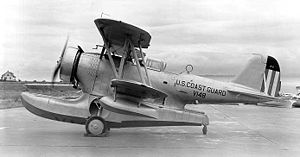Grumman JF Duck
| JF Duck | |
|---|---|
 |
|
| Grumman JF-2 Duck in United States Coast Guard service | |
| Role | Utility amphibian |
| National origin | United States |
| Manufacturer | Grumman |
| First flight | 24 April 1933 |
| Introduction | 1935 |
| Primary users |
United States Navy United States Marine Corps Argentine Navy United States Coast Guard |
| Number built | 48 |
| Variants | Grumman J2F Duck |
The Grumman JF "Duck" was an American single-engine amphibious biplane built by Grumman for the United States Navy during the 1930s. The J2F Duck was an improved version of the JF, with its main difference being a longer float.
The Grumman JF Duck was manufactured from 1934 until 1936, when production switched to the J2F Duck and later variants. The more obvious external appearance clue to distinguish a JF from an early J2F is the deletion of the inter-aileron strut between the wings on the J2F; less noticeable perhaps is the J2F's slightly longer rear fuselage/float joining fillet beneath the tail.
The Duck's main pontoon was part of the fuselage, almost making it a flying boat, though it appears more like a standard aircraft with an added float. This general configuration was shared with the earlier Loening OL. The XJF-1 prototype first flew on 24 April 1933 piloted by Grumman test pilot Paul Hovgard.
The JF-1 that was first ordered, had the same Pratt & Whitney R-1830-62 engine as the XJF-1 prototype. The US Navy ordered 27 JF-1s with the first Ducks delivered beginning in May 1934 to Norfolk NAS. These early production series had provisions for mounting a machine gun at the rear seat facing aft, a single bomb rack mounted under each wing, capable of carrying a 100 lb (45.4 kg) bomb or depth charge on each. The main float was also a Grumman design (Grumman Model "A") and like the prototype, it included retractable main landing gear, making the Duck a true amphibian. Ducks served as general/utility amphibians for photographic, target-towing, scouting and rescue work.
...
Wikipedia
